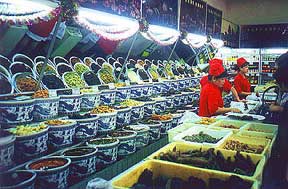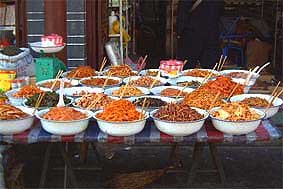
Xinhua news agency January 13/2003
China looks to relocate popular vegetable
Hangzhou: Chinese scientists are rushing to find suitable land for a special vegetable from areas to be flooded later this year for the Three Gorges dam project, experts said Sunday [12 January]. Fuling District in Chongqing Municipality, southwest China, the place
Yuan Xingping, a geological engineer from Chongqing, said the raw material for the pickle was mainly produced in an area 200 km by 20 km with Fuling at the centre along the 6,300-km Yangtze River, the third longest river in the world. The area will be part of the reservoir, which consists of long embankments of the river and a huge dam in Yichang section of the river in Hubei Province. Work to relocate local residents is coming to an end and experts are looking for farmland with identical properties elsewhere for the tuber.

Geological experts are also looking for alternative places for other local specialities, such as oranges produced in Fengjie county and pomelo citrus fruit from Liangping. The two areas will also be inundated soon by the reservoir.
In addition to the relocation of the plants, billions of dollars have earmarked by the Chinese government to resettle a total of one million residents to make way for the reservoir. A number of cultural heritage, rare and endangered species of plants in the planned reservoir area have been moved to safe areas.
The water level will rise to 135 metres in the reservoir by 30 June of this year and the first group of generating units of the Three Gorges Project will start generating power. The project, which is estimated to cost 200bn yuan (24.1bn US dollars), is expected to generate 84.7 billion kWh of electricity annually, equivalent of about 50m tons of standard coal upon completion in 2009.
Agricultural experts said chemical elements in soil are key to what can be grown, and China launched its first geological survey on property of farmland last year, involving an area of 550,000 sq.km. The survey will enable China to have better knowledge about the properties of the soil, nutriments and water resources in different areas. Zhang said China had drawn up its first soil chemical element map covering 36,000 sq.km in Zhejiang Province, east China, or about one third of the land in the province.